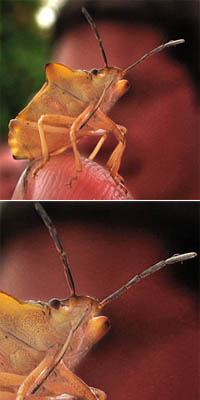What Makes a Bug a "True Bug"?

The insects that experts call bugs have many different body shapes, sizes and colors. However, the one thing they all have in common is a long slender beak shaped mouth part that looks like a straw. They use this beak to poke through plants and occasionally animal skin and suck out sap or blood.
Most true bugs have their front pair of wings partially hardened and only the tips clear, it looks like they have half a wing. Entomologists use this strange wing shape to give this group of insects their official name, “Hemiptera”, which means half wing in Greek. Their rear pair of wings is shorter than the front half wings and are completely clear except for the thin lines that run their length. These lines are called veins and strengthen the wing in flight and help provide folds to store the wing under the front wings when not flying.
Hemiptera also have antennae with very few joints (segments), usually about five. Their number of foot joints (tarsi) is also small with usually no more than three. All the other insect groups that look similar to Hemiptera, like cockroaches and some beetles, have much longer antennae and feet with more segments in them.
How true bugs are organized is shown in the diagram below. The order for all true bugs is Hemiptera which is divided into four suborders, Auchenorrhyncha, Coleorrhyncha, Heteroptera and Sternorrhyncha.

Read more about: True Bugs
Bibliographic details:
- Article: True Bug Characteristics
- Author(s): Dr. Biology
- Publisher: Arizona State University School of Life Sciences Ask A Biologist
- Site name: ASU - Ask A Biologist
- Date published: 6 Oct, 2010
- Date accessed:
- Link: https://askabiologist.asu.edu/true-bug-anatomy
APA Style
Dr. Biology. (Wed, 10/06/2010 - 19:22). True Bug Characteristics. ASU - Ask A Biologist. Retrieved from https://askabiologist.asu.edu/true-bug-anatomy
Chicago Manual of Style
Dr. Biology. "True Bug Characteristics". ASU - Ask A Biologist. 06 Oct 2010. https://askabiologist.asu.edu/true-bug-anatomy
Dr. Biology. "True Bug Characteristics". ASU - Ask A Biologist. 06 Oct 2010. ASU - Ask A Biologist, Web. https://askabiologist.asu.edu/true-bug-anatomy
MLA 2017 Style
Be Part of
Ask A Biologist
By volunteering, or simply sending us feedback on the site. Scientists, teachers, writers, illustrators, and translators are all important to the program. If you are interested in helping with the website we have a Volunteers page to get the process started.



